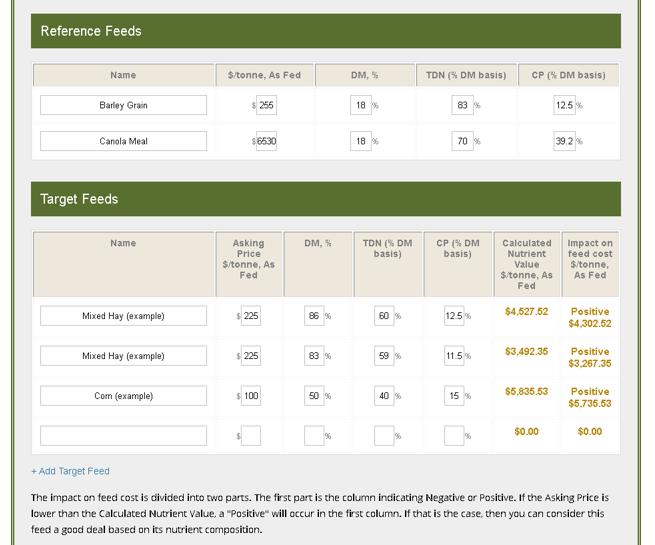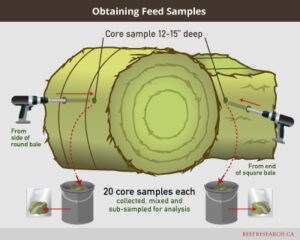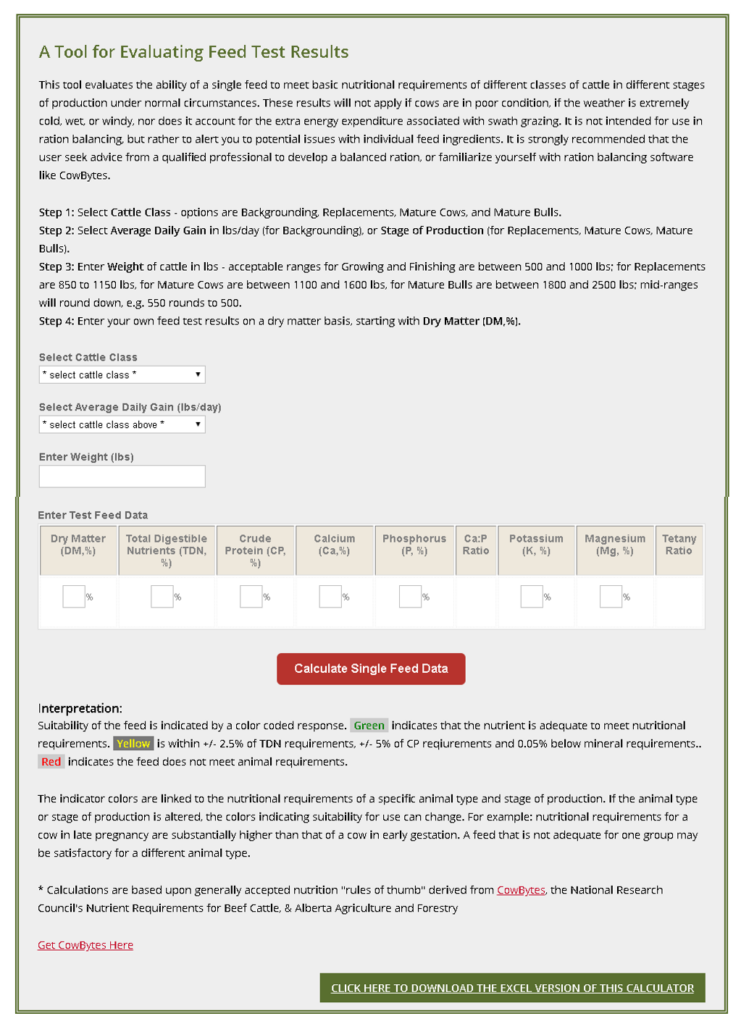New Feed Testing Tools
When you don’t know the quality of feed on an operation, maintaining animal health and welfare can become significantly more difficult. Visual assessment of feedstuffs is not accurate enough to access quality and may lead to cows being underfed and losing body condition or wasting money on expensive supplements that aren’t necessary. Two new decision-making tools on this page, developed by the Alberta Beef, Forage and Grazing Centre, will help you use feed test results to flag potential nutritional problems, and identify the comparative economic value of different feeds based on their quality.
Why feed test?
- Avoid sneaky production problems, such as poor gains or reduced conception caused by mineral or nutrient deficiencies or excesses;
- Prevent or identify potentially devastating problems due to toxicity from mycotoxins, nitrates, sulfates, or other minerals or nutrients;
- Develop appropriate rations that meet the nutritional needs of their beef cattle;
- Identify nutritional gaps that may require supplementation;
- Economize feeding, and possibly make use of opportunities to include diverse ingredients;
- Accurately price feed for buying or selling.
Collecting feed samples
It’s critical to collect a feed sample that is representative of the feed ingredients that you are testing. Any feed type that will be used to feed beef cattle can and should be analysed, including baled forages and straw, by-products, silage, baleage, grain, swath grazing, cover crops, and corn.
Feed quality will change as the feeding season progresses. Samples should be taken as close to feeding or selling as possible, while leaving enough time for the results to come back from the lab.
*New* A Tool for Evaluating Feed Test Results
This tool evaluates the ability of a single feed to meet basic nutritional requirements of different classes of cattle in different stages of production under normal circumstances. It is not intended for use in ration balancing, but rather to alert you to potential issues with individual feed ingredients. Suitability of the feed is indicated by a color-coded response. Green indicates that the nutrient is adequate to meet nutritional requirements. Yellow is within +/- 2.5% of TDN requirements, +/- 5% of CP requirements and 0.05% below mineral requirements. Red indicates the feed does not meet animal requirements.
One of the major benefits of feed testing is preventing costly and devastating problems before they start. Every season is different and some years there is an abundance of high-quality forage. Other years, there is a lack of available feed, or perhaps there is an abundance of low-quality forage, grain, or grain by-products available that may look economical but can potentially pose significant risks if a feed analysis has not been performed or understood.
Feed is often bought on weight (e.g. by the ton or by the bale) with little consideration of the economic value of feed quality. Especially when feed supplies are tight, comparing the economic value of different feed sources on a quality basis will help you stretch your feed dollars further while ensuring animal requirements are met. Another new tool on this page will help you do just that. Enter your feed test results to get the estimated “economic” value of the feed compared to your choice of reference feeds. The higher the value, the higher the cumulative content of TDN and CP of the targeted feed, and thus the higher the feed value. The results will tell you which feeds have the best potential from an economic perspective to be used in the final formulation of a ration.

Learn more about feed testing and test drive the new calculators
Click here to subscribe to the BCRC Blog and receive email notifications when new content is posted.
The sharing or reprinting of BCRC Blog articles is welcome and encouraged. Please provide acknowledgement to the Beef Cattle Research Council, list the website address, www.BeefResearch.ca, and let us know you chose to share the article by emailing us at info@beefresearch.ca.
We welcome your questions, comments and suggestions. Contact us directly or generate public discussion by posting your thoughts below.

